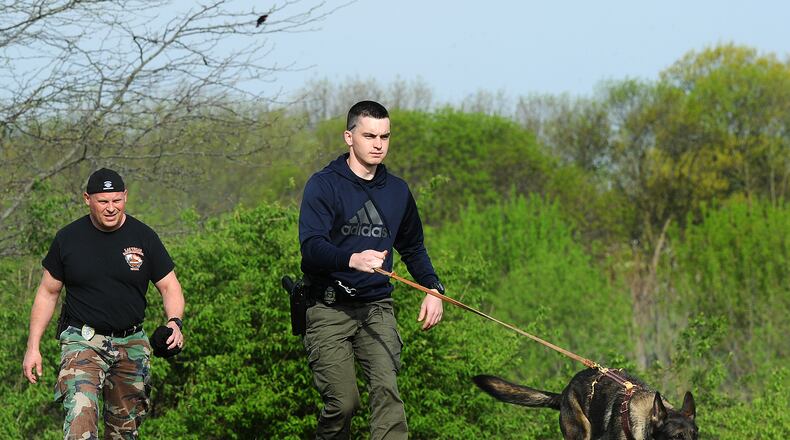This is the seventh time Kettering has hosted this academy and has already trained 10 teams of K-9s and handlers. However, Lambert said this is the largest class they have trained with six teams.
Lambert, a certified K-9 trainer through the Ohio Peace Officer Training Academy, said he saw an opportunity in 2012 where training all the K-9s locally the same way could help each of the departments when there is a need to sniff out a vehicle for drugs, track down a fleeing suspect, search a building, and other patrol duties.
“All of the dogs able to perform to a similar level,” Lambert said. “We’ve offered the free course to build up a network of similarly trained K-9s from member agencies of the South Dayton Tactical Crime Suppression Unit.”
Lambert said right now, there are four K-9s available and three are from Kettering. The other agencies not part of the TCSU, were invited to have their dogs trained because those communities wanted to get their dogs working on the street quickly.
The training for the handlers and K-9s is provided free to the other departments and saves time later because police departments know the abilities of each K-9s when there is a need to call in for assistance from another agency.
The regional academy teaches the K-9s how to search for evidence, drugs, apprehension, tracking as well as searching an area, a vehicle or a building. The K-9s get training in obedience and agility. As part of the obedience training, the K-9s are put through their paces and blanks are fired close by and from a short distance to ensure the dog is focused on the handler’s commands.
After the 12 weeks of training is completed, OPOTA will send down evaluators to determine if the K-9s are certified to hit the streets with their partners.
The dogs range in age from 14 months to age 4. Beavercreek police Officer David Ashworth is the handler for Mickey, the youngest dog in the course, while Franklin police Officer Olen Keil is the handler for Liza, the oldest dog in the course at age 4.
Liza was recently donated by retired Franklin police officer Steve Dunham, a former K-9 officer, who also owns a dog training business in Kettering.
During a tracking exercise, that was about 225 yards long and had three turns, K-9s from Franklin, Beavercreek and Hamilton tracked down a toy that was left by another trainer, Kettering Detective Kevin Hoying, who previously worked seven years as a former K-9 officer in Springfield.
Hoying said the dogs can track a person through human odor, skin cells and recent ground disturbance with no problems. He changed up the course for each dog.
Stryder and Officer Wyatt Arnold, Hamilton’s new K-9 team found his toy in less than 3 minutes. After each track, Lambert would critique the team and offer suggestions on how to improve or better control the K-9.
Arnold, who comes from a family of police officers, has been with Hamilton police for nine years. His father started the K-9 program and handled three K-9s during his career with the Phelps County Sheriff’s Department in Missouri and his mother was a police officer in Rolla, Mo. Now, he’s following in the family tradition.
He said Hamilton is adding a third dog with Stryder. Arnold said the previous two HPD K-9s were trained at the Middletown police academy, but Hamilton wanted to get their K-9s trained and certified and did not want to wait for the next class in Middletown to begin later this year.
Arnold said he likes the tracking part of the job because the gratitude in finding a fleeing suspect is the greatest reward for him. “It’s the best thing I like about being a K-9 officer,” he said.
Mickey and his handler, Beavercreek Officer David Ashworth, also did well on the course to find the toy.
“It’s a whole different side of police work,” Ashworth said. “I’m learning the dog and his behaviors.”
He said Mickey will be replacing another K-9 when Hans retires next year.
“We’re really lucky to be part of the Kettering class,” said Franklin Officer Olen Keil. “For us this is a big difference. I’ve been extremely lucky to get this opportunity.”
He said the trainers are always changing things up so the handlers and their K-9s learn and adjust to different things.
“I’m really surprised they offer this program for free,” he said.
Lambert said a “green dog” costs between $8,900 to $10,000 each and training could be $8,000 to more than $10,000. In addition, it costs $1,500 to $1,600 for uniforms and special leashes and other equipment. Departments also have to purchase a special cruiser with a compartment for the K-9 along with alarms for heat, tinting, and pop-open doors. This in addition to the officer’s salary and benefits and the K-9′s veterinarian bill, shots and food.
About the Author





